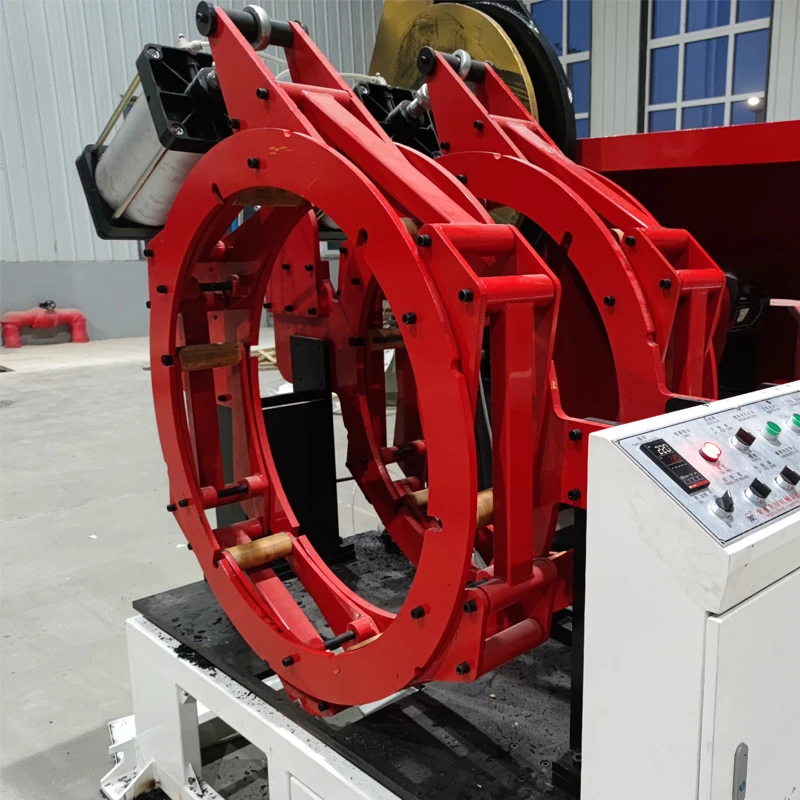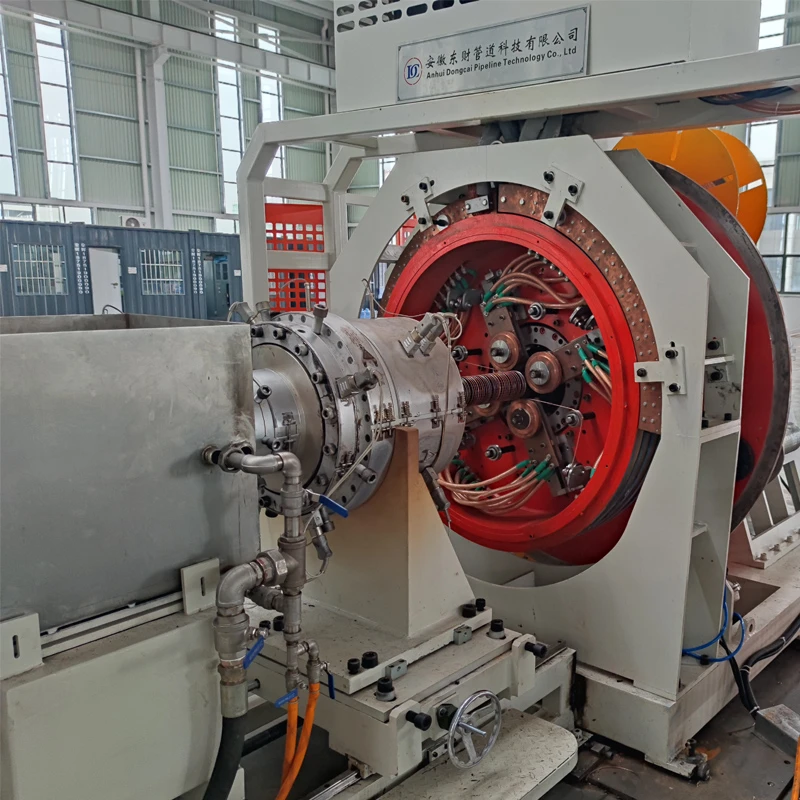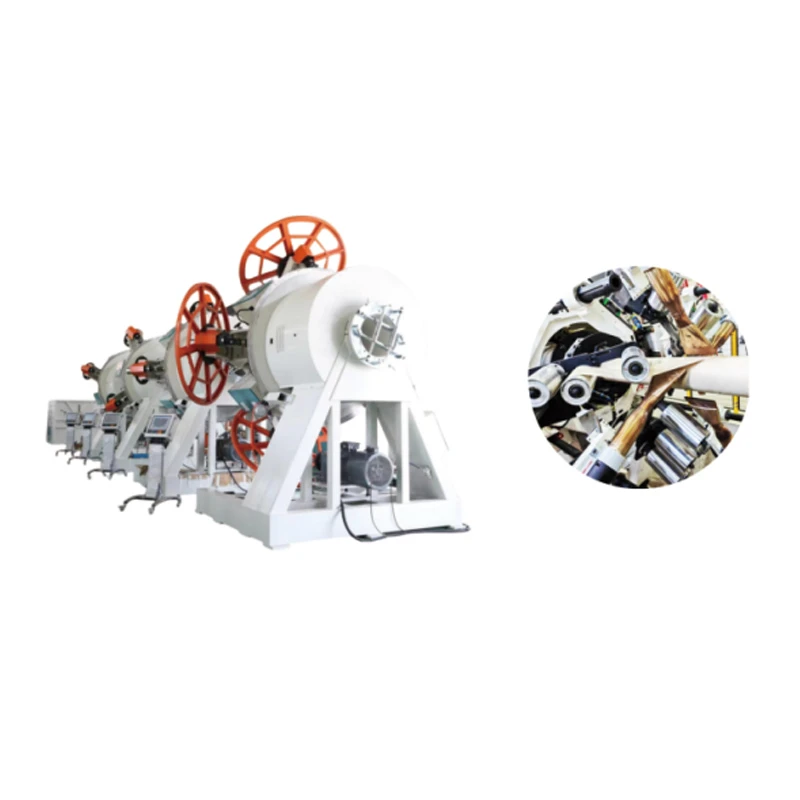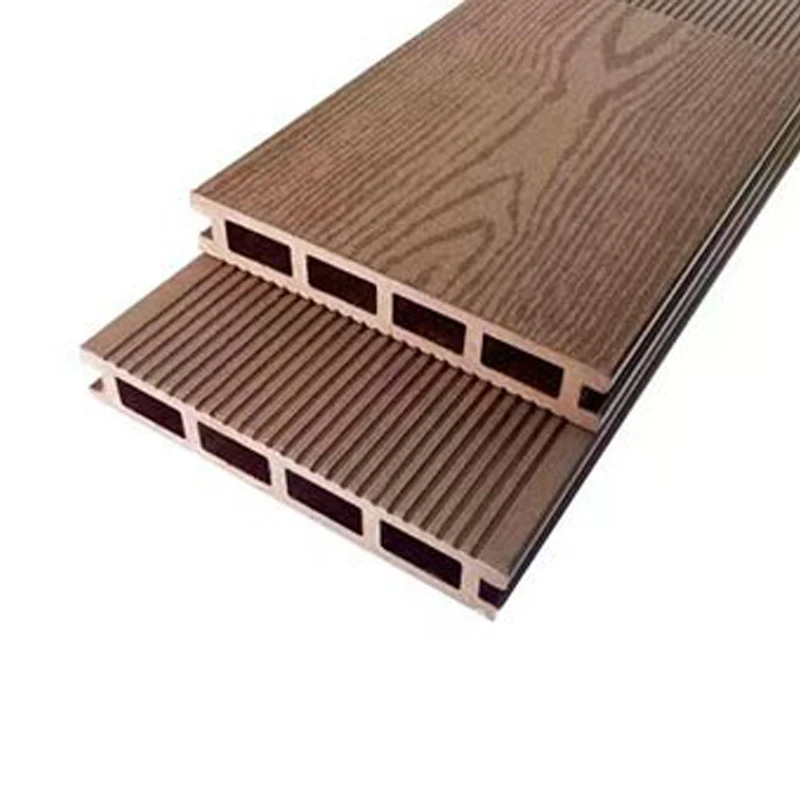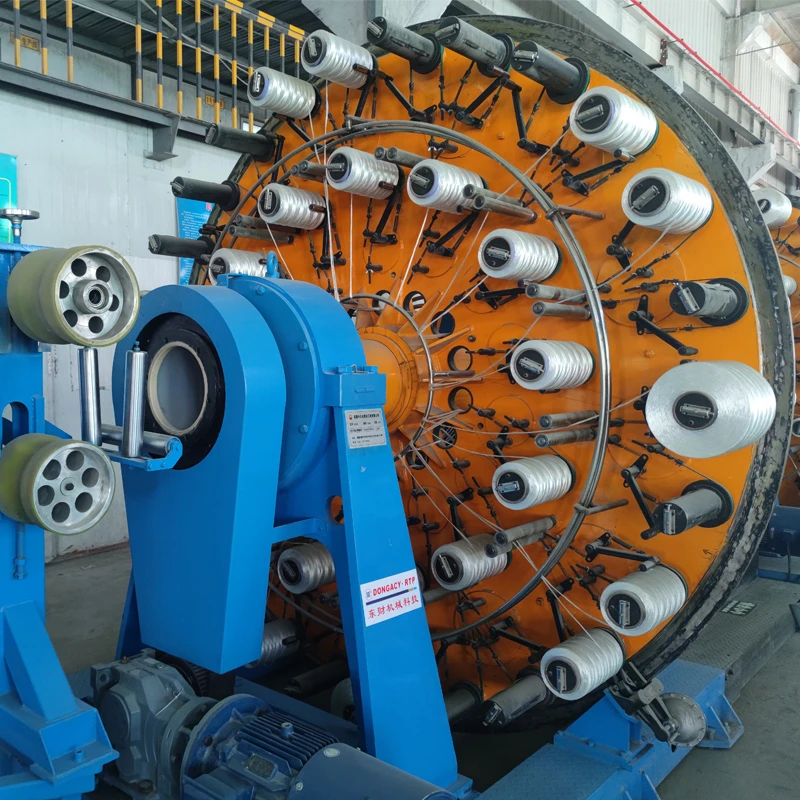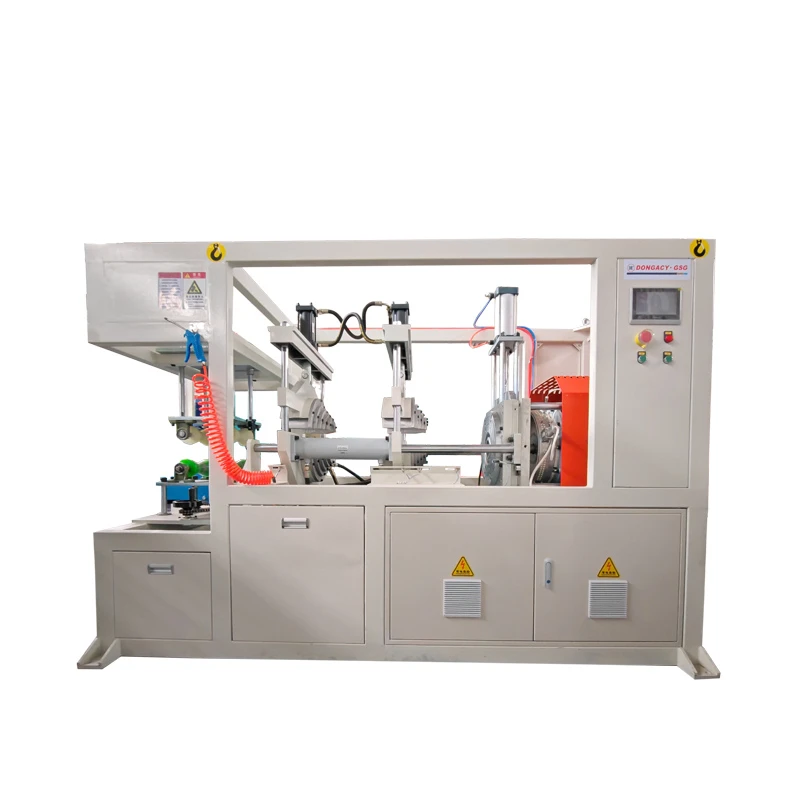
Explore the intricate factors influencing the hdpe machine price, with an in-depth analysis of the RTP Tape Winding Reinforced Composite Pipe Production Line. Understand the technology, applications, and ROI that define a smart investment in the high-pressure pipeline industry.
Industry Outlook: Why Composite Pipes Are Reshaping the Market
The global demand for durable, corrosion-resistant, and high-pressure pipelines is surging. Traditional materials like steel are increasingly being replaced by advanced composites. According to a market analysis by Grand View Research, the global composite pipe market is projected to grow significantly, driven by the oil & gas, water distribution, and chemical industries. This shift directly impacts the demand and, consequently, the hdpe machine price for equipment that produces these next-generation pipes.
The core of this revolution is the Reinforced Thermoplastic Pipe (RTP), a type of **composite pipe production line** product that combines the flexibility of High-Density Polyethylene (HDPE) with the immense strength of reinforcement materials like aramid, glass fiber, or steel wire. Understanding the manufacturing technology behind these pipes is crucial for any stakeholder evaluating the initial investment and long-term profitability.
Deep Dive: The RTP Tape Winding Reinforced Composite Pipe Production Line
At the heart of modern composite pipe manufacturing is the RTP Tape Winding Reinforced Composite Pipe Production Line. This is not just a single machine but an integrated system of precision components working in harmony. The final hdpe machine price reflects the complexity, output capacity, and technological sophistication of this entire line. Let's break down its manufacturing process to understand where the value lies.
Manufacturing Process Deconstructed: From Raw Pellet to High-Pressure Pipe
Raw Material Preparation & Extrusion
The process begins with high-grade HDPE (PE100) pellets, selected for their high Melt Flow Index (MFI) and stress crack resistance. These pellets are fed into a high-efficiency single-screw extruder. Inside the barrel, the material is melted, mixed, and plasticized under precise temperature and pressure control, a key factor in the final pipe quality and a determinant of the hdpe machine price.
Inner HDPE Liner Pipe Formation
The molten HDPE is forced through a die head to form the seamless inner liner pipe. This liner serves as the corrosion-resistant, fluid-tight barrier. The thickness and concentricity are monitored in real-time by ultrasonic sensors, ensuring compliance with standards like ISO 4427. This precision engineering contributes significantly to the system's cost.
Reinforcement Tape Winding (The Core Technology)
This is the most critical stage. The cooled liner pipe enters a multi-station tape winding machine. Spools of high-tensile strength reinforcement tapes (e.g., Aramid, Glass Fiber, or Steel Cord) are wound around the liner at a precise, computer-controlled angle and tension. The number of layers and winding angle determines the pipe's pressure rating (up to 20 MPa or more), directly linking capability to the hdpe machine price.
Adhesive/Bonding Layer Application
A thermoplastic adhesive layer is co-extruded over the reinforcement tapes. This ensures a perfect, monolithic bond between the reinforcement layer and the outer protective jacket, preventing delamination under high pressure and thermal cycling. This is a crucial step for achieving a long service life of 50+ years.
Outer HDPE Jacket Extrusion
A final, rugged outer jacket of HDPE is extruded over the bonded reinforcement layer. This jacket is often colored or striped for identification and provides UV protection and mechanical resistance against installation damage. The quality of this outer layer is vital for the pipe's durability in harsh environments like petrochemical plants or mining sites.
Cooling, Haul-off, and Cutting
The finished composite pipe passes through a series of vacuum calibration and spray cooling tanks to solidify its structure and dimensions. A caterpillar-style haul-off machine pulls the pipe at a consistent speed, synchronized with the extruder output. Finally, a planetary, chipless cutter provides clean, precise cuts to the desired length without damaging the pipe's structural integrity.
Technical Advantages & ROI Analysis
Investing in a high-quality **composite pipe production line** offers significant advantages over traditional manufacturing. The upfront hdpe machine price is justified by long-term operational savings and superior product performance.
Corrosion Immunity
Unlike steel pipes, RTP pipes are completely immune to internal and external corrosion from H₂S, CO₂, and saline water. This eliminates the need for costly coatings, cathodic protection, and inhibitors, drastically reducing lifetime maintenance costs.
High Pressure & Flow Rate
The reinforcement layer provides exceptional strength, allowing for high-pressure applications (often exceeding API 15S standards). The smooth inner bore of HDPE minimizes friction, leading to higher flow efficiency and reduced pumping energy costs by up to 30% compared to steel.
Lightweight & Flexibility
RTP pipes are up to 75% lighter than equivalent steel pipes. This translates into massive savings in transportation, handling, and installation. Fewer heavy machines are needed, and installation is faster, especially in challenging terrains. The pipe's flexibility allows for coiling on reels, enabling long, joint-free installations.
Exceptional Service Life
Engineered for longevity, these composite pipes have a design life of over 50 years, even in the most demanding industries like oil & gas, mining slurry transport, and high-pressure water injection. This durability ensures a lower total cost of ownership.
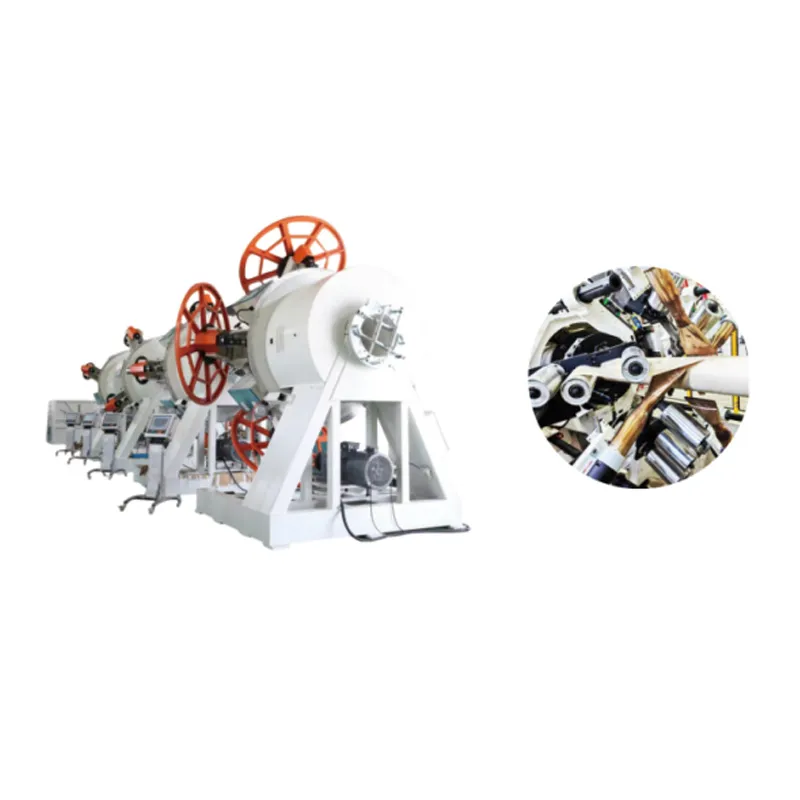
Analyzing the hdpe machine price: A Comparative Overview
The price of an HDPE machine, particularly a complex **composite pipe production line**, is not a single number. It's a spectrum influenced by capacity, technology, automation level, and manufacturer reputation. Below is a comparative table to help contextualize the investment.
| Parameter | Basic HDPE Pipe Line | Mid-Range RTP Line | High-End, High-Speed RTP Line |
|---|---|---|---|
| Pipe Diameter Range | 50mm - 250mm | 75mm - 400mm | 110mm - 630mm |
| Max. Output Capacity | 150-300 kg/hr | 300-600 kg/hr | 600-1200 kg/hr |
| Max. Pressure Rating | N/A (SDR based) | 10 MPa (1450 PSI) | > 20 MPa (2900 PSI) |
| Reinforcement Tech | None | Glass Fiber / Polyester Tape | Aramid / Steel Cord Tape |
| Control System | Manual / PLC Basic | Siemens PLC with Touch Screen | Fully Integrated Siemens/ABB System with Gravimetric Dosing |
| Key Features | Standard Extrusion | Ultrasonic Thickness Control, Synchronized Winding | Real-time Data Logging, Remote Diagnostics, Chipless Cutter |
| Indicative hdpe machine price Range | $50,000 - $150,000 | $200,000 - $500,000 | $500,000 - $1,500,000+ |
Note: Prices are illustrative and can vary widely based on customization, manufacturer, and included ancillary equipment.
Technical Specifications: RTP Tape Winding Reinforced Composite Pipe Production Line
For a precise evaluation, examining the technical sheet is paramount. Here are the key performance indicators for a state-of-the-art **composite pipe production line**, such as the one offered by industry leaders.
| RTP Tape Winding Reinforced Composite Pipe Production Line - Key Specifications | |
|---|---|
| Product Name | RTP Tape Winding Reinforced Composite Pipe Production Line |
| Applicable Materials | Inner/Outer Layer: HDPE PE100, PE-RT; Reinforcement: Aramid Fiber, Glass Fiber, Steel Wire, Polyester Tape |
| Pipe Diameter Range | Φ50mm - Φ630mm |
| Design Pressure | 3.0 MPa to 25.0 MPa (customizable) |
| Design Standard Compliance | API 15S, SY/T 6662.1, ISO/TS 18226 |
| Extruder Model | High-efficiency Single Screw Extruder (e.g., AHDC-90/36) |
| Winding Machine Type | High-speed Planetary Cage or Shuttle Type with Precision Tension Control |
| Control System | Siemens S7-1500 PLC with Profinet, Centralized HMI, Remote Access Module |
| Line Speed | Up to 15 m/min (depending on pipe diameter and wall thickness) |
| Power Consumption | Optimized for energy efficiency; approx. 20-30% lower than previous generation models |
| Quality Control Systems | Online Ultrasonic Scanning System, Gravimetric Control System, Diameter/Ovality Laser Gauges |
| Estimated Service Life of Machine | > 15 Years with proper maintenance |
Data-Driven Insights: Performance & Market Visualization
Visualizing data helps to grasp the advantages of RTP pipes and understand their market positioning. A higher initial hdpe machine price for an advanced line is justified by the superior properties of the end product.
Performance Comparison: RTP vs. Steel Pipe
■ RTP Pipe ■ Carbon Steel Pipe
RTP Pipe Application Market Share (Estimated)
- ■ 45% - Oil & Gas (Onshore Collection & Injection)
- ■ 30% - Water & Wastewater (High-pressure distribution)
- ■ 15% - Mining (Slurry and dewatering lines)
- ■ 10% - Industrial & Chemical Transport
Manufacturer & Solution Customization: Beyond the Standard Price Tag
Choosing a manufacturer is as critical as choosing the technology itself. A reputable supplier does not just quote a generic hdpe machine price; they provide a comprehensive, customized solution.
What to Look for in a Manufacturer (Authoritativeness & Trustworthiness):
- Industry Experience & Certification: Look for manufacturers with 10+ years of specialized experience in composite machinery and ISO 9001:2015 certification. Authority is demonstrated by a track record of successful installations with major industry players (e.g., partnerships with national oil companies or municipal water authorities).
- Customization Capability: Can the manufacturer adapt the line for specific resins, reinforcement tapes, or unique diameter/pressure requirements? A one-size-fits-all approach is a red flag. The ability to provide a turnkey solution, including ancillary equipment like chillers, dryers, and material handling systems, is key.
- Technical Support & Training: A robust after-sales service promise, including installation supervision, operator training, and readily available spare parts, is non-negotiable. This builds trust and ensures the long-term success of your investment.
- Material Science Expertise: The best manufacturers have in-house experts who can advise on material selection (e.g., choosing between aramid and glass fiber for a specific chemical application) and processing parameters. This level of expertise is a hallmark of quality.
Case Study: Solving a High-Pressure Water Injection Challenge (Experience)
Client: A national oil company in the Middle East.
Challenge: Existing carbon steel pipelines for high-salinity water injection were failing prematurely due to severe internal corrosion, leading to frequent, costly shutdowns. They needed a reliable solution with a 20+ year lifespan for a 10-inch pipeline operating at 12 MPa.
Solution: We proposed a customized RTP production line. The final hdpe machine price was higher than a standard line, but it was engineered specifically for their needs:
- Reinforcement: Utilized high-modulus Aramid fiber tapes for superior long-term creep resistance under constant high pressure.
- Material: Specified a bimodal PE100-RC (Resistant to Crack) grade for the inner and outer layers to handle the harsh installation conditions and aggressive fluid.
- Quality Control: Integrated a full closed-loop quality system with real-time wall thickness and diameter monitoring to ensure every meter of pipe met API 15S specifications.
Result: The client successfully established in-country production of high-pressure RTP pipes, reducing their reliance on expensive imports and eliminating corrosion-related failures. The project ROI was achieved in under three years due to savings on maintenance and operational uptime. This case study showcases how a tailored solution provides value far beyond the initial equipment cost.
Frequently Asked Questions (FAQ) - Building Trust Through Knowledge
A standard HDPE pipe machine is an extruder-based system designed to produce single-layer, solid-wall pipes, where pressure resistance is determined solely by the wall thickness (SDR ratio). An RTP **composite pipe production line** is a far more complex, multi-stage system. It includes the base extruder but adds critical components like high-speed, precision reinforcement tape winding machines and additional co-extruders for bonding and outer layers. The hdpe machine price for an RTP line is substantially higher because it produces a high-performance, multi-layered composite product capable of handling pressures far beyond what monolithic HDPE can achieve.
The choice of reinforcement material is critical and impacts both the machine configuration and the pipe's properties.
- Glass Fiber: Offers a good balance of strength and cost. It's suitable for mid-range pressure applications. The winding machine must handle the material's specific tension and abrasion properties.
- Aramid Fiber (e.g., Kevlar®): Provides the highest strength-to-weight ratio and excellent fatigue resistance, ideal for very high-pressure or dynamic applications. It requires winding machines with highly precise tension control systems.
- Steel Cord: Offers very high stiffness and strength but adds weight and reduces flexibility compared to fiber. The winding and bonding process is different, often requiring specialized die heads and heating systems.
Both the machinery and the final product must meet stringent international standards to ensure safety and reliability. Key standards include:
- API 15S: The American Petroleum Institute's standard for Spoolable Reinforced Plastic Line Pipe, a benchmark in the oil & gas industry.
- ISO 9001:2015: For the manufacturer's quality management system, ensuring consistency and quality in the machine-building process.
- ISO/TS 18226: A technical specification for reinforced thermoplastic piping systems for gaseous fuels.
- ASTM F2945: Standard Specification for Reinforced Polyethylene (PE) Composite Pipe for High-Pressure Applications.
Hoop stress is the circumferential stress in the pipe wall caused by internal pressure. It's the primary force that a pipe must withstand to avoid bursting. In a standard HDPE pipe, this stress is handled by the plastic material itself. In an RTP pipe, the reinforcement tapes are wound at specific angles (typically close to 54.7 degrees, the "magic angle") to absorb almost all of the hoop stress. The inner HDPE liner is primarily for fluid containment, not pressure handling. This efficient distribution of forces is what allows RTP pipes to achieve such high pressure ratings with a relatively thin wall.
The delivery cycle for such a complex piece of machinery typically ranges from 4 to 6 months from contract signing to ex-works delivery. This includes design finalization, procurement of high-quality components (like Siemens controls or ABB motors), manufacturing, assembly, and factory acceptance testing (FAT). A standard warranty from a reputable manufacturer is typically 12-18 months from the date of commissioning or shipment. This warranty covers defects in materials and workmanship, and it is a key part of the trust-building process with the client.
Yes, modern high-end production lines are designed with Industry 4.0 principles in mind. Using communication protocols like Profinet or OPC-UA, the line's central PLC system can be integrated with your Manufacturing Execution System (MES) or Enterprise Resource Planning (ERP) software. This allows for real-time monitoring of production data, material consumption, OEE (Overall Equipment Effectiveness), and energy usage, enabling smarter, data-driven management of your factory operations.
Regular preventive maintenance is crucial for optimal performance and longevity. Key activities include:
- Daily/Weekly: Checks on lubrication systems, sensor cleaning, and visual inspection of moving parts (belts, chains).
- Monthly: Calibration of sensors (temperature, pressure, ultrasonic), inspection of extruder screw and barrel wear, and tension checks on winding units.
- Annually: Comprehensive inspection by a certified technician, replacement of high-wear parts (heater bands, seals), and software updates.
Your Next Step: Get a Custom Quote
Understanding the nuances of a composite pipe production line is the first step. The next is to partner with an expert who can translate your specific needs into a powerful, profitable manufacturing solution. The ultimate hdpe machine price is a reflection of the value, reliability, and long-term performance you receive.
Request a Detailed Quote for Your ProjectFurther Reading & Industry References
To deepen your expertise, we recommend exploring these authoritative sources that discuss the materials, standards, and market trends relevant to composite piping and its manufacturing technology.
- Plastics Pipe Institute (PPI): The PPI TR-4, "PPI's Policies and Procedures for Developing Hydrostatic Design Basis (HDB)," provides foundational knowledge on pressure rating plastic materials. Explore PPI Technical Reports.
- CompositesWorld: An excellent resource for news and articles on the latest advancements in composite materials, including fibers used in RTP. Visit the Oil & Gas Zone.
- Society of Petroleum Engineers (SPE): Publishes numerous technical papers and journals on the application of non-metallic materials in the oil and gas industry. Searching their OnePetro library for "Reinforced Thermoplastic Pipe" yields extensive research. Access the OnePetro Library.
-
Innovative Solutions in PVC Pipe Production LineNewsJul.18,2025
-
Innovative Solutions in Pipe Extrusion Production LineNewsJul.18,2025
-
Advanced Plastic Profile Extrusion SolutionsNewsJul.18,2025
-
PVC Profiles: The Future of Durable and Cost-Effective Construction SolutionsNewsJun.06,2025
-
PVC Pipe Extrusion LineNewsJun.06,2025
-
High-Quality Polyethylene Pipe Production LineNewsJun.06,2025
-
High-Performance Tube Production LineNewsJun.06,2025

